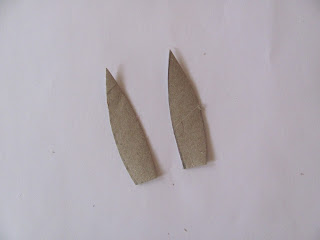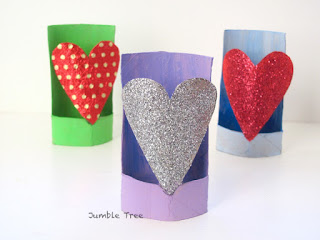These make great table decorations for a Easter day spread. You could even write the children's (and adults..) names on them, before filling with treats like mini eggs.
You will need:
Toilet paper tube (or two)
Scissors
Pencil
Ruler
Paint
Glue
Glue stick
Black pen (gel or felt-tip)
Green paper (optional)
Coloured tissue paper
Feathers (optional)
1. Flatten the cardboard tube with your hand - press down along the sides, so you can see the creases.
6. With a pencil, draw half an 'n' shape on the fold, so it goes about halfway up the tube. Leave a space between the pencil shape and the side cuts.
7. Cut around the shape to the pencil line (*mini makers might need help cutting through the double card). Snip through the crease at the top, above the shape (see pic below), so you can bend each side piece down, and fold on the line. Now they're easier to snip off.
When you squeeze the tube back into shape you will have the body for your chick or bunny.
8. For the head, draw around something like a coin or a bottle top on spare card and cut out (if there isn't enough card left, cut open another toilet paper tube and use that.)
9. (Bunny only) Fold some spare card and draw a rabbit ear on top. Cut through the double card * to get two identical ears. For an easier option, use paper instead.
10. Now you have all your pieces, it's painting time. Paint behind the body first - use a nice, bright colour. Then paint the body and the other pieces. Paint a small piece of spare card (or paper) orange, for the chick's beak.
You could paint the foreground, below your chick or bunny green, or make paper grass (in step 12)
We also cut long zig-zags into the back of the tube, to make it look like the rabbit's hiding in some grass.
11. Use a black pen to draw on the faces. For the chick, cut out a small triangle from the piece of painted orange card (or use paper), and use a small amount of glue to stick it under the eyes. Glue the bunny ears behind the head.
12. If you would like to make some grass for the front of your egg holder, cut out a strip of green paper (or colour in some plain paper). It needs to wrap round half your tube and be about a cm or so higher that the pencil line at the front.
14. Cut zig-zags along the strip - keep them short and make them uneven.
15. Glue the grass below your chick or bunny, lining it up with the bottom of the tube - a glue stick is good for this, just rub a layer of glue on the back of the grass.
16. For the flowers, scrunch up small squares of coloured tissue paper, dot some glue on the grass, where you want them to go, and stick in place.
17. Glue the chick's head on and if you have two feathers, glue them either side. If you don't have feathers, you could cut some wings out of paper and colour in.
For the bunny, glue the head onto the body.
You could use a paper clip to keep things in place while the glue dries, or prop them on their sides.
And why not customise your egg holder with some blingy sequins before adding Easter treats.
(They're a perfect size for a creme egg.. )
Linking up with #bloggerclubuk
































































